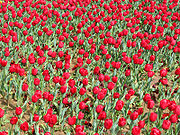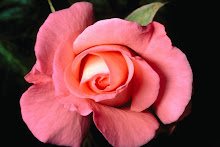Tulip

| Tulip | ||||||||||||
|---|---|---|---|---|---|---|---|---|---|---|---|---|
Cultivated Tulip - 2005, Canberra | ||||||||||||
| Scientific classification | ||||||||||||
| ||||||||||||
| Species | ||||||||||||
| See text |
Tulipa commonly called Tulip is a genus of about 100 species of bulbous flowering plants in the family Liliaceae. The native range of the species include southern Europe, north Africa, and Asia from Anatolia and Iran in the east to northeast of China. The centre of diversity of the genus is in the Pamir and Hindu Kush mountains and the steppes of Kazakhstan. A number of species and many hybrid cultivars are grown in gardens, used as pot plants or as fresh cut flowers.
Contents1. Description2 Origin of the Name 3 Cultivation 3.1 Propagation 4 Diseases 4.1 Introduction to Western Erope 5 Selected Spices 6 See Also 7 References and External Links 8 Gallery |
Description
The species are perinnials bulbs, the tunicate bulbs are often produced on the ends of stolons covered with glabrous to variously hairy papery coverings. The species include short low growing plants to tall upright plants, growing from 10 to 70 centimeters (4–27 in) tall. Plants with typically 2 to 6 leaves, with some species having up to 12 leaves. The cauline foliage is strap-shaped, waxy-coated, usually light to medium green and alternately arranged. The blades are somewhat fleshy and linear to oblong in shape. The large flowers produced on scapes or subscapose stems normally lacking bracts. The stems have no leaves to a few leaves, with large species having some leaves and smaller species have none. Typically species have one flower per stem but a few species have up to four flowers. The colorful and attractive cup shaped flowers have three petels three sepals, which are most often termed tepals because they are nearly identical. The six petaloid tepals are often marked near the bases with darker markings. The flowers have six basifixed, distinct stamens with filaments shorter than the tepals and the stigmas are districtly 3-lobed. The ovaries are superior with three chambers. The 3 fruits are leathery textured, ellipsoid to subglobose in shape, containing numerous flat disc-shaped seeds two rows per locule.
Origin of the Name
Although tulips are associated with Holland, both the flower and its name originated in the Ottoman Empire. The tulip is actually not a Dutch flower as many people tend to believe. The tulip, or "Lale" as it is called in Turkey, is a flower indigenous to Iran, Afghanistan, Turkey and other parts of Central Asia. A Dutch ambassador in Turkey in the 16th century, who was also a great floral enthusiast, Ogier Ghiselin de Busbecq, got their very names because of their Persian origins. Tulips were brought to Europe in the 16th century; the word tulip, which earlier in English appeared in such forms as tulipa or tulipant, entered the language by way of French tulipe and its obsolete form tulipan or by way of Modern Latin tulīpa, from Ottoman Turkish tülbend, "muslin, gauze." (The English word turban, first recorded in English in the 16th century, can also be traced to Ottoman Turkish tülbend.) The Turkish word for gauze, with which turbans can be wrapped, seems to have been used for the flower because a fully opened tulip was thought to resemble a turban.
Cultivation
Tulips originate from mountainous areas with temperate climates and need a period of cool dormancy. They do best in climates with long cool springs and early summers, but they are often grown as spring blooming annual plantings in warmer areas of the world. The bulbs are typically planted in late summer and fall, normally from 10 to 20 cm (4 to 8 in.) deep, depending of the type planted, in well draining soils. In parts of the world that do not have long cool springs and early summers, the bulbs are often planted up to 12 inches deep, this provides some protection from the heat of summer and tends to force the plants to regenerate one large bulb each year instead of many smaller non blooming ones. This can extend the usefulness of the plants in warmer areas a few years but not stave off the degradation in bulb size and eventual death of the plants.
Propagation
Tulips can be propagated through offsets, seeds or micropropagation. Offsets and tissue culture methods are means of asexual propagation, they are used to produce genetic clones of the parent plant which maintains cultivar integrity. Seed raised plants show greater variation, and seeds are most often used to propagate species and subspecies or are used for the creation of new hybrids. Many tulip species can cross pollinate with each other, when tulip populations overlap with other species or subspecies they very often hybridize producing populations of mixed plants in the wild. Most tulip cultivars are complex hybrids and sterile, those plants that produce seeds produce offspring very dissimilar to the parents.
In horticulture, tulips are divided up into fifteen groups mostly based on flower morphology and plant size.
- Single early group - with cup-shaped single flowers, no larger than 8cm across (3 inches). They bloom early to mid season. Growing 15 to 45cm tall.
- Double early group - with fully double flowers, bowl shaped to 8cm across. Plants typically grow from 30-40cm tall.
- Triumph group - single, cup shaped flowers up to 6cm wide. Plants grow 35-60cm tall and bloom mid to late season.
- Darwin hybrid group - single flowers are ovoid in shape and up to 8cm wide. Plants grow 50-70cm tall and bloom mid to late season. This group should not be confused with older Darwin tulips - which belong in the Single Late Group below.
- Single late group - cup or goblet-shaded flowers up to 8cm wide, some plants produce multi-flowering stems. Plants grow 45-75cm tall and bloom late season.
Tulip growers using offsets to produce salable plants need a year or more of growth before plants are large enough to flower; tulips grown from seeds often need five to eight years of growth before the plants are large enough to flower. Commercial growers harvest the bulbs in late summer and they are graded into sizes; bulbs large enough to flower are sorted and sold, while smaller bulbs are sorted into sizes and replanted. Holland is the main producer of commercially sold plants, producing as many as 3 billion bulbs annually.
Diseases
Botrytis tulipae is a major fungal disease that affects tulips, causing cell death which leads to the production of rotten plants.Other pathogens include Anthracnose, bacterial soft rot, blight caused by Sclerotium rolfsii, bulb nematodes, other rots including blue molds, black molds and mushy rot.
Historical variegated varieties - such as those admired during the Dutch tulipomania, gained their delicately feathered patterns as a result of an infection with Tulip Breaking potyvirus. The mosaic virus is carried by green peach aphids, Myzus persicae, an insect that was common in European gardens of the seventeenth century. While the virus produces fantastically beautiful flowers, it also caused the plants to weaken and die slowly. Today the virus is almost completely eradicated from growers' fields. Tulips affected by the mosaic virus are often called "Broken tulips" will occasionally revert to plain or solid coloring, but usually revert to their colorful condition when grown from offsets, since the virus is still present in the tissue.
Some historical cultivars have had a striped, "feathered", "flamed", or variegated flower, as in the illustration below. While some modern varieties also display multicoloured patterns, this results from a natural change in the upper and lower layers of pigment in the tulip flower.
The Black Tulip was the title of a historical romance by Alexandre Dumas, père (1850), in which the city of Haarlem has a reward outstanding for the first grower who can produce a truly black tulip. This fascination with growing a black tulip, a biologically impossible task, was historically accurate to the tulipomania in which the novel is set.
Introduction to Western Europe

It is unclear who first brought the Tulip to northwest Europe. The most widely accepted story is that of Oghier Ghislain de Busbecq, Ambassador from Ferdinand I to Suleyman the Magnificent of the Ottoman Empire in 1554. He remarked in a letter that he saw "an abundance of flowers everywhere; Narcissus, hyacinths, and those which in Turkish Lale, much to our astonishment, because it was almost midwinter, a season unfriendly to flowers" (see Busbecq, qtd. in Blunt, 7). It is worth mentioning that the words Narcissus (Narges) and Lale (Laleh) originally come from Persian. In Persian Literature (classic and modern) special attention has been given to these two flowers, in specific likening the beloved eyes to Narges and a glass of wine to Laleh.
By 1559, an account by Conrad Gessner described tulips flowering in Augsburg, Bavaria, in the garden of Councillor Herwart. Due to the nature of the tulip's growing cycle, the bulbs are generally removed from the ground in June, and they must be replanted again by September to endure the winter. Busbecq's account of the supposed first sighting of tulips by a European is likely spurious. While possible, it is doubtful that Busbecq could successfully have had the tulip bulbs removed, shipped, and replanted between his first sighting of them in March 1558 and Gessner's description in 1559. After introduction of the Tulip to Europe, it gained much popularity and was seen as a sign of abundance and indulgence in the Ottoman Empire. The era which the Ottoman Empire was wealthiest is called the Tulip era, or Lale Devri in Turkish.
Another oft-quoted account is that of Lopo Vaz de Sampayo, governor of the Portuguese possessions in India. When he returned to Portugal in disgrace after usurping his position from the rightful governor, Sampayo supposedly took tulip bulbs with him from Sri Lanka. This tale too, however, does not hold up to scrutiny; tulips do not occur in Sri Lanka, and the island itself is far from the route Sampayo's ships should have taken.
Regardless of how the flower originally arrived in Europe, its popularity soared quickly. Charles de L'Ecluse (Clusius) is largely responsible for the spread of tulip bulbs in the final years of the sixteenth century. He was the author of the first major work on tulips, completed in 1592. Clusius had already begun to note and remark upon the variations in colour that made the tulip so admired. His admiration of tulips quickly spread to others. While occupying a chair in the medical faculty of the University of Leiden, Clusius planted both a teaching garden and his own private plot with tulip bulbs. In 1596 and 1598 Clusius suffered thefts from his garden, with over a hundred bulbs stolen in a single raid.
Between 1634 and 1637, the early enthusiasm for the new flowers triggered a speculative frenzy now known as the tulip mania and tulip bulbs were then considered a form of currency. The Netherlands are still associated with tulips. The term 'Dutch tulips' is often used for the cultivated forms. Tulip Festivals are held in the Netherlands, Spalding (England) and in North America every May. Tulips are now also popular in Australia, and several festivals are held during September and October in the Southern Hemisphere's spring. The world's largest permanent display of tulips, although open to the public only seasonally, is in Keukenhof, in the Netherlands.
Selected species
See also
References and external links
- ^ Flora of North America Editorial Committee. 2002. Flora of North America. north of Mexico Vol. 26, Magnoliophyta : Liliidae : Liliales and orchidales. New York: Oxford University Press. ISBN 0195152085 26 Page 199
- ^ Nishiuchi, Y. 1986. MULTIPLICATION OF TULIP BULB BY TISSUE CULTURE IN VITRO. Acta Hort. (ISHS) 177:279-284
- ^ Brickell, Christopher, and Judith D. Zuk. 1997. The American Horticultural Society A-Z encyclopedia of garden plants. New York, N.Y.: DK Pub. ISBN 0789419432 page 1028.
- ^ Floridata: Tulipa spp
- ^ A. Leon Reyes, T.P. Prins, J.-P. van Empel, J.M. van Tuyl ISHS Acta Horticulturae 673: IX International Symposium on Flower Bulbs. DIFFERENCES IN EPICUTICULAR WAX LAYER IN TULIP CAN INFLUENCE RESISTANCE TO BOTRYTIS TULIPAE
- ^ Westcott, Cynthia, and R. Kenneth Horst. 1979. Westcott's Plant disease handbook. New York: Van Nostrand Reinhold. ISBN 0442235437 page 709.
- Blunt, Wilfrid. Tulipomania
- Clusius, Carolus. A Treatise on Tulips
- Dash, Mike. Tulipomania
- Pavord, Anna. The Tulip
- Pollan, Michael. The Botany of Desire
- Old Tulips
- Canadian National Capital Commission: The Gift of Tulips
- Greig's tulip (tulipa greigii) in its original habitat in Kazakhstan
- Lalades (Tulips of Chios: Tulipa praecox, Tulipa aegenensis, Tulipa clusiana, and Tulipa undulatifolia)
- elegant-tulip-bulbs.com: Information about 3700 tulip names
- Tulip photos
- Tulip species
































No comments:
Post a Comment